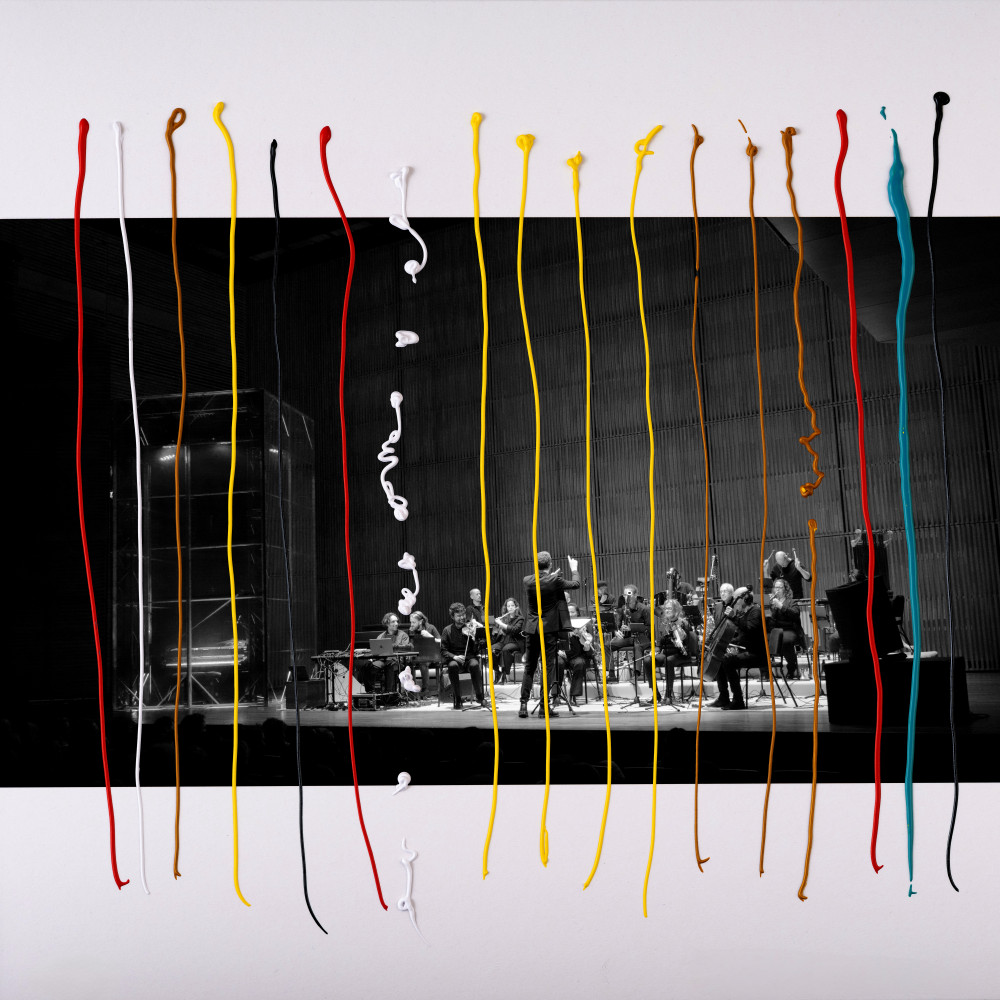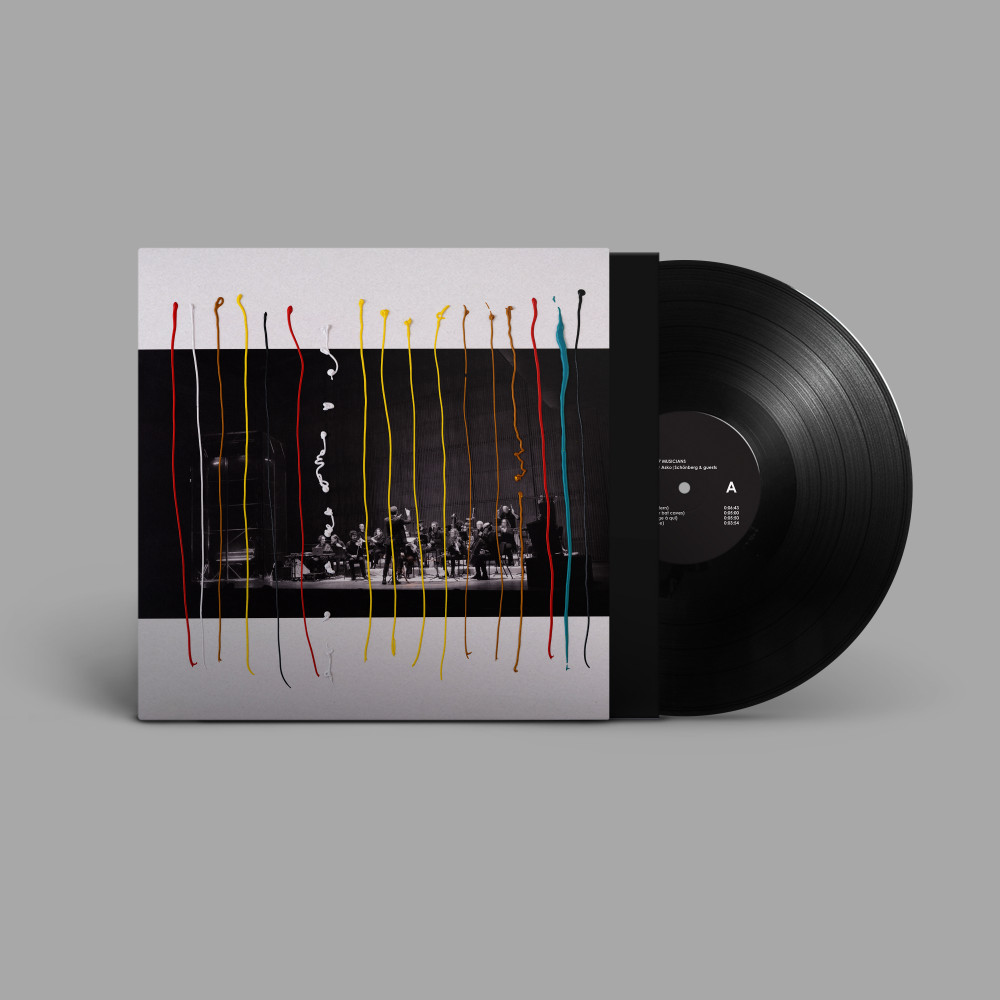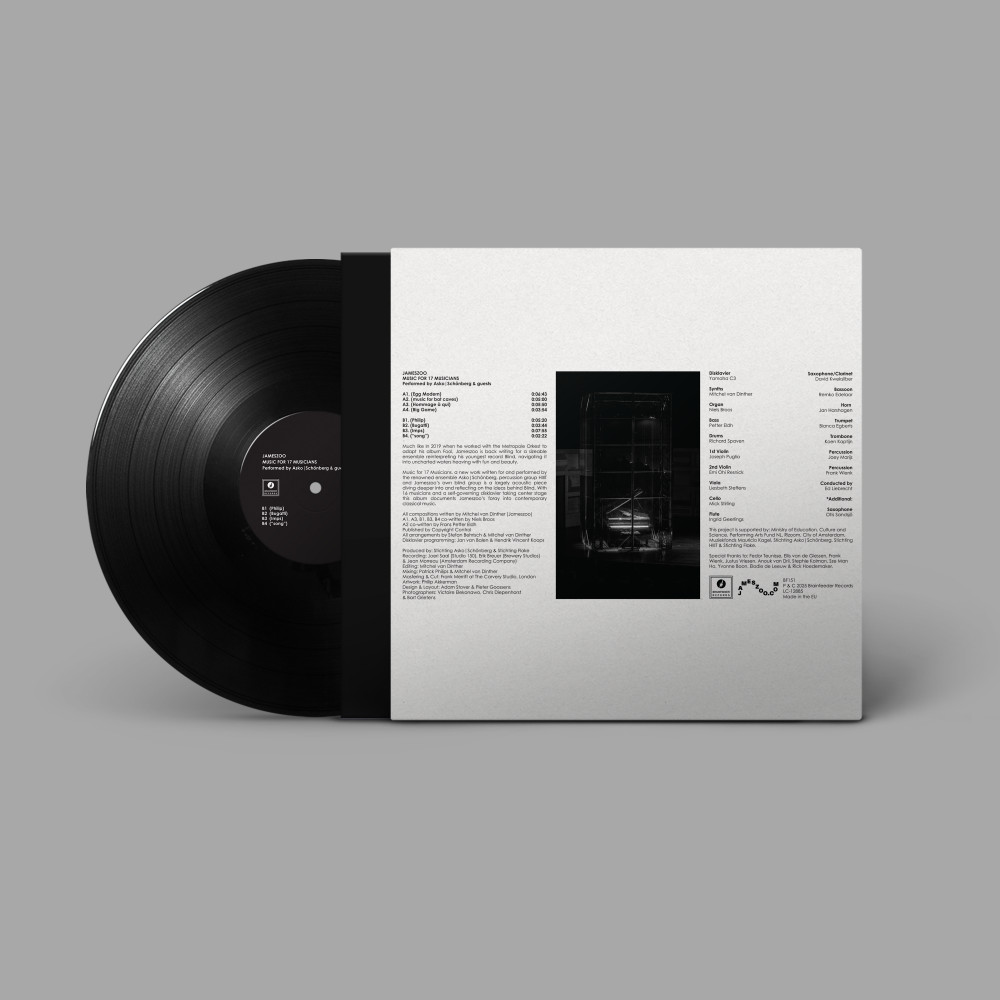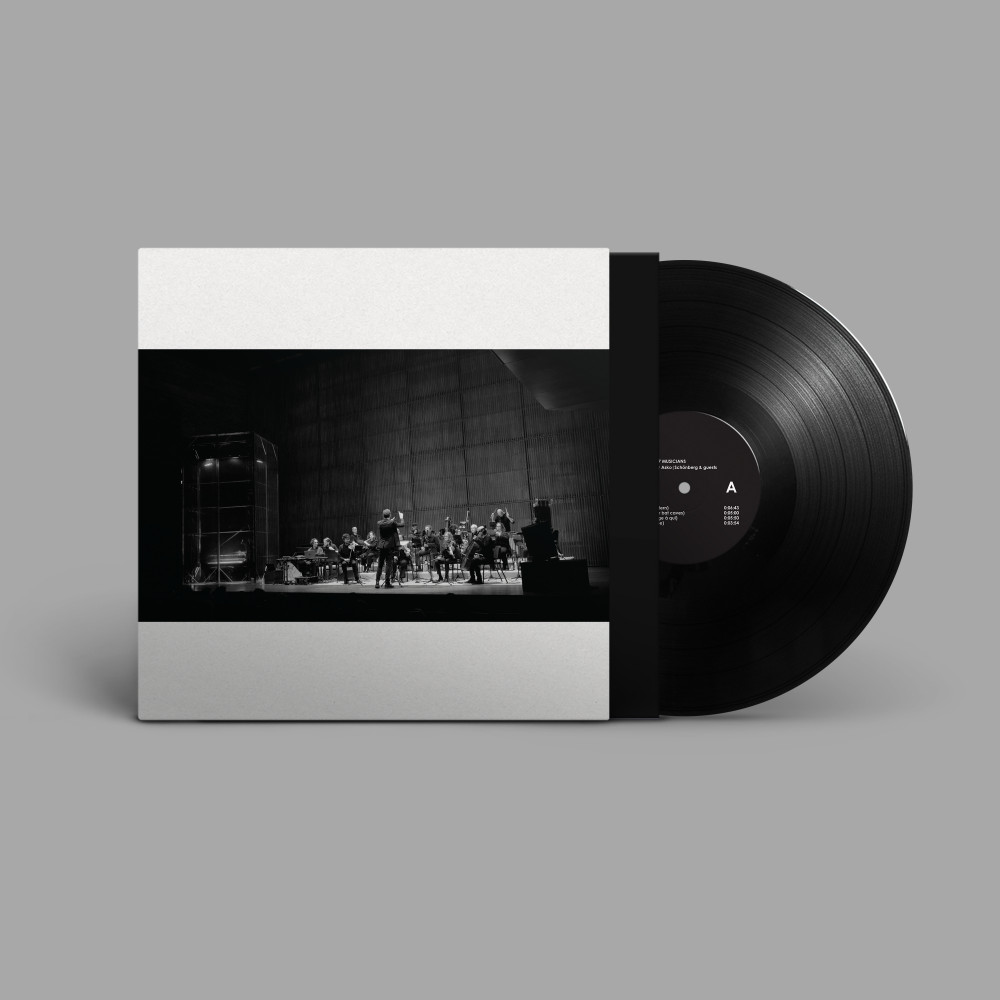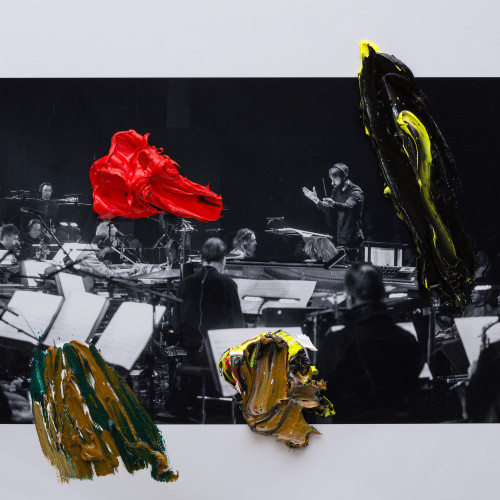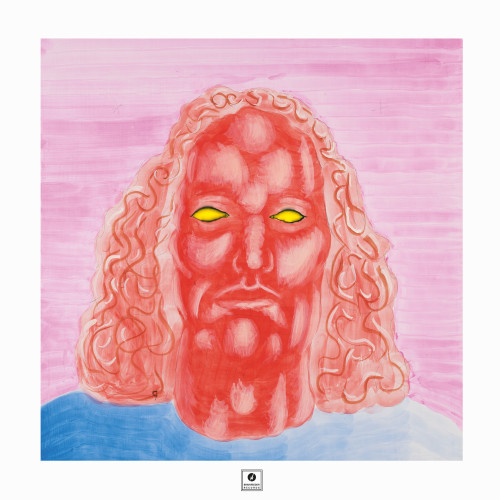Music for 17 Musicians
by Jameszoo with Asko|Schönberg
— Released 30th May 2025 on Brainfeeder
Jameszoo (Mitchel van Dinther) returns to Brainfeeder with a wonderfully cinematic album embarking on adventures on the fringes of jazz and contemporary classical. Imbued with the same spirit of adventure and experimental outlook as his previous work on the label, ‘Music for 17 Musicians’ is a new work written for and performed by the renowned Dutch ensemble Asko|Schönberg, percussion group HIIIT and Jameszoo’s own “blind” group: Niels Broos (organ), Petter Eldh (electric bass) and Richard Spaven (drums). Much like in 2019 when he worked with the Grammy-winning Metropole Orkest and Jules Buckley to adapt his album ‘Fool’, ‘Music for 17 Musicians’ is a largely acoustic piece diving deeper into and reflecting on the ideas behind his 2022 album ‘Blind’. With 16 musicians and a self-governing disklavier taking center stage this album documents the Dutchman’s foray into contemporary classical music. The title is a nod to Steve Reich’s masterful 1978 album on ECM ‘Music for 18 Musicians’.
“Late in 2022 I was approached by Dutch contemporary music ensemble Asko|Schönberg to ask if I would be interested in writing a new piece for them,” explains Mitchel. “Apart from the fact that I thought this group of fantastic musicians would be a lovely fit for music in the spirit of ‘Blind’, I also always loved the idea of expanding on and continuing a process… being able to show more than one side to a work.”
One of the principal ideas underpinning ‘Blind’ was the notion of active objective listening. “In music and other arts there is a heavy emphasis on the artist,” says Mitchel. “Which composer, which soloist, which performer… and the shifting emphasis between them all colours what we hear. Is it possible to create something that bypasses this?” In reality his explorations only threw up more questions, but this only fuelled van Dinther’s desire to explore further. How is the listener’s perception affected when you try to detach the composer/musician/artist from a work?
Van Dinther started out by working with self-playing robotic instruments to embody the music without the use of human hands. “This created something visually special but was ultimately just a magic trick to fool myself as all these instruments were merely citing what I was giving them as input. There were no autonomous choices being made by these instruments whatsoever, which made me wonder, would it be possible for an instrument to experience some sort of freedom within the context of my music?”
Deciding to focus on a single instrument, van Dinther gave a player piano a pivotal role in his compositions. However, for this concept to work this player piano would need the capacity to make autonomous musical decisions whilst performing (in the way a human improviser or a soloist would do). The player piano is an instrument invented in the late 1800s mainly used for reproducing piano music at home, but there is also a strong tradition in contemporary ensemble
music written for these machines. You can communicate with a modern player piano instructing it what notes to play and when to play them by sending it MIDI information. MIDI is a digital language used for these kinds of musical instructions.
Excited by the possibilities herein, van Dinther contacted a couple of expert friends Hendrik Vincent Koops and Jan van Balen and asked if they wanted to help create this. They opted for making a set of algorithms that could communicate and instruct the player piano through generating custom MIDI. “We created a chain of musical rules per song… rules we thought would be interesting within this context,” explains Mitchel. “We created custom datasets for all of this with the help of fantastic musicians like Kit Downes, Matthew Bourne and Niels Broos. Vincent and Jan decided they wanted to write and script these algorithms mostly by using Markov models and LSTMs. (Markov models and LSTMs are models used in statistical and self learning systems to analyse and generate data). Vincent and Jan ultimately made this dream into a reality!”
When it came to the music written for the rest of the ensemble Mitchel wanted to create something that would showcase some of the specific capabilities of the fantastic musicians. Pieces that would build on the foundation of ‘Blind’ but quoting it freely more so than directly citing it. “I knew I wanted to invite musicians from my own group (Richard Spaven, Petter Eldh and Niels Broos) and I wanted to extend the percussion section by inviting my friend Frank Wienk from percussion group HIIIT. I sat down with the music and started working on all different parts occasionally helped by my friends and longtime collaborators Niels Broos and Petter Eldh. To help me with the final arrangements I asked Stefan Behrisch with whom I worked on the music that became the 2019 album ‘Melkweg’ with Metropole Orkest and Jules Buckley.”
‘Music for 17 Musicians’ is released on Friday 30th May on vinyl/digital formats via Brainfeeder Records. A strictly limited hand-painted and numbered LP edition (of 200) by Mitchel’s longtime friend Philip Akkerman is available exclusively via Bandcamp/Brainfeeder Store.Jameszoo (Mitchel van Dinther) returns to Brainfeeder with a wonderfully cinematic album embarking on adventures on the fringes of jazz and contemporary classical. Imbued with the same spirit of adventure and experimental outlook as his previous work on the label, ‘Music for 17 Musicians’ is a new work written for and performed by the renowned Dutch ensemble Asko|Schönberg, percussion group HIIIT and Jameszoo’s own “blind” group: Niels Broos (organ), Petter Eldh (electric bass) and Richard Spaven (drums). Much like in 2019 when he worked with the Grammy-winning Metropole Orkest and Jules Buckley to adapt his album ‘Fool’, ‘Music for 17 Musicians’ is a largely acoustic piece diving deeper into and reflecting on the ideas behind his 2022 album ‘Blind’. With 16 musicians and a self-governing disklavier taking center stage this album documents the Dutchman’s foray into contemporary classical music. The title is a nod to Steve Reich’s masterful 1978 album on ECM ‘Music for 18 Musicians’.
“Late in 2022 I was approached by Dutch contemporary music ensemble Asko|Schönberg to ask if I would be interested in writing a new piece for them,” explains Mitchel. “Apart from the fact that I thought this group of fantastic musicians would be a lovely fit for music in the spirit of ‘Blind’, I also always loved the idea of expanding on and continuing a process… being able to show more than one side to a work.”
One of the principal ideas underpinning ‘Blind’ was the notion of active objective listening. “In music and other arts there is a heavy emphasis on the artist,” says Mitchel. “Which composer, which soloist, which performer… and the shifting emphasis between them all colours what we hear. Is it possible to create something that bypasses this?” In reality his explorations only threw up more questions, but this only fuelled van Dinther’s desire to explore further. How is the listener’s perception affected when you try to detach the composer/musician/artist from a work?
Van Dinther started out by working with self-playing robotic instruments to embody the music without the use of human hands. “This created something visually special but was ultimately just a magic trick to fool myself as all these instruments were merely citing what I was giving them as input. There were no autonomous choices being made by these instruments whatsoever, which made me wonder, would it be possible for an instrument to experience some sort of freedom within the context of my music?”
Deciding to focus on a single instrument, van Dinther gave a player piano a pivotal role in his compositions. However, for this concept to work this player piano would need the capacity to make autonomous musical decisions whilst performing (in the way a human improviser or a soloist would do). The player piano is an instrument invented in the late 1800s mainly used for reproducing piano music at home, but there is also a strong tradition in contemporary ensemble
music written for these machines. You can communicate with a modern player piano instructing it what notes to play and when to play them by sending it MIDI information. MIDI is a digital language used for these kinds of musical instructions.
Excited by the possibilities herein, van Dinther contacted a couple of expert friends Hendrik Vincent Koops and Jan van Balen and asked if they wanted to help create this. They opted for making a set of algorithms that could communicate and instruct the player piano through generating custom MIDI. “We created a chain of musical rules per song… rules we thought would be interesting within this context,” explains Mitchel. “We created custom datasets for all of this with the help of fantastic musicians like Kit Downes, Matthew Bourne and Niels Broos. Vincent and Jan decided they wanted to write and script these algorithms mostly by using Markov models and LSTMs. (Markov models and LSTMs are models used in statistical and self learning systems to analyse and generate data). Vincent and Jan ultimately made this dream into a reality!”
When it came to the music written for the rest of the ensemble Mitchel wanted to create something that would showcase some of the specific capabilities of the fantastic musicians. Pieces that would build on the foundation of ‘Blind’ but quoting it freely more so than directly citing it. “I knew I wanted to invite musicians from my own group (Richard
Spaven, Petter Eldh and Niels Broos) and I wanted to extend the percussion section by inviting my friend Frank Wienk from percussion group HIIIT. I sat down with the music and started working on all different parts occasionally helped by my friends and longtime collaborators Niels Broos and Petter Eldh. To help me with the final arrangements I asked Stefan Behrisch with whom I worked on the music that became the 2019 album ‘Melkweg’ with Metropole Orkest and Jules Buckley.”
‘Music for 17 Musicians’ is released on Friday 30th May on vinyl/digital formats via Brainfeeder Records. A strictly limited hand-painted and numbered LP edition (of 200) by Mitchel’s longtime friend Philip Akkerman is available exclusively via Bandcamp/Brainfeeder Store.
Music for 17 Musicians
by Jameszoo with Asko|Schönberg
— Released 30th May 2025 on Brainfeeder
Physical |
|---|
|
LP (BF151L)
Ltd Edition Handpainted LP 140g black vinyl LP housed in a 3mm spined outer sleeve. Black paper inner. Photography by Victoire Elekonawo, Chris Diepenhorst and Bart Grietens. Layout and design by Adam Stover and Pieter Goossens. Strictly limited handpainted and numbered edition by Philip Akkerman. Edition of 200. |
|
LP (BF151)
140g black vinyl LP housed in a 3mm spined outer sleeve. Black paper inner. Photography by Victoire Elekonawo, Chris Diepenhorst and Bart Grietens. Layout and design by Adam Stover and Pieter Goossens. |
Physical |
Digital |
||
|---|---|---|---|
|
LP (BF151L)
Ltd Edition Handpainted LP 140g black vinyl LP housed in a 3mm spined outer sleeve. Black paper inner. Photography by Victoire Elekonawo, Chris Diepenhorst and Bart Grietens. Layout and design by Adam Stover and Pieter Goossens. Strictly limited handpainted and numbered edition by Philip Akkerman. Edition of 200. |
MP3 (BFDNL151) | ||
|
LP (BF151)
140g black vinyl LP housed in a 3mm spined outer sleeve. Black paper inner. Photography by Victoire Elekonawo, Chris Diepenhorst and Bart Grietens. Layout and design by Adam Stover and Pieter Goossens. |
16-bit WAV (BFDNL151W) | ||
Tracklist
- LP
- LP
- MP3
- 16-bit WAV
-
1
(Egg Modern)
-
2
(music for bat caves)
-
3
(Hommage à qui)
-
4
(Big Game)
-
5
(Philip)
-
6
(Bugatti)
-
7
(Imps)
-
8
(“song”)
-
Play All (8)
-
1
(Egg Modern)
-
2
(music for bat caves)
-
3
(Hommage à qui)
-
4
(Big Game)
-
5
(Philip)
-
6
(Bugatti)
-
7
(Imps)
-
8
(“song”)
-
Play All (8)
Jameszoo (Mitchel van Dinther) returns to Brainfeeder with a wonderfully cinematic album embarking on adventures on the fringes of jazz and contemporary classical. Imbued with the same spirit of adventure and experimental outlook as his previous work on the label, ‘Music for 17 Musicians’ is a new work written for and performed by the renowned Dutch ensemble Asko|Schönberg, percussion group HIIIT and Jameszoo’s own “blind” group: Niels Broos (organ), Petter Eldh (electric bass) and Richard Spaven (drums). Much like in 2019 when he worked with the Grammy-winning Metropole Orkest and Jules Buckley to adapt his album ‘Fool’, ‘Music for 17 Musicians’ is a largely acoustic piece diving deeper into and reflecting on the ideas behind his 2022 album ‘Blind’. With 16 musicians and a self-governing disklavier taking center stage this album documents the Dutchman’s foray into contemporary classical music. The title is a nod to Steve Reich’s masterful 1978 album on ECM ‘Music for 18 Musicians’.
“Late in 2022 I was approached by Dutch contemporary music ensemble Asko|Schönberg to ask if I would be interested in writing a new piece for them,” explains Mitchel. “Apart from the fact that I thought this group of fantastic musicians would be a lovely fit for music in the spirit of ‘Blind’, I also always loved the idea of expanding on and continuing a process… being able to show more than one side to a work.”
One of the principal ideas underpinning ‘Blind’ was the notion of active objective listening. “In music and other arts there is a heavy emphasis on the artist,” says Mitchel. “Which composer, which soloist, which performer… and the shifting emphasis between them all colours what we hear. Is it possible to create something that bypasses this?” In reality his explorations only threw up more questions, but this only fuelled van Dinther’s desire to explore further. How is the listener’s perception affected when you try to detach the composer/musician/artist from a work?
Van Dinther started out by working with self-playing robotic instruments to embody the music without the use of human hands. “This created something visually special but was ultimately just a magic trick to fool myself as all these instruments were merely citing what I was giving them as input. There were no autonomous choices being made by these instruments whatsoever, which made me wonder, would it be possible for an instrument to experience some sort of freedom within the context of my music?”
Deciding to focus on a single instrument, van Dinther gave a player piano a pivotal role in his compositions. However, for this concept to work this player piano would need the capacity to make autonomous musical decisions whilst performing (in the way a human improviser or a soloist would do). The player piano is an instrument invented in the late 1800s mainly used for reproducing piano music at home, but there is also a strong tradition in contemporary ensemble
music written for these machines. You can communicate with a modern player piano instructing it what notes to play and when to play them by sending it MIDI information. MIDI is a digital language used for these kinds of musical instructions.
Excited by the possibilities herein, van Dinther contacted a couple of expert friends Hendrik Vincent Koops and Jan van Balen and asked if they wanted to help create this. They opted for making a set of algorithms that could communicate and instruct the player piano through generating custom MIDI. “We created a chain of musical rules per song… rules we thought would be interesting within this context,” explains Mitchel. “We created custom datasets for all of this with the help of fantastic musicians like Kit Downes, Matthew Bourne and Niels Broos. Vincent and Jan decided they wanted to write and script these algorithms mostly by using Markov models and LSTMs. (Markov models and LSTMs are models used in statistical and self learning systems to analyse and generate data). Vincent and Jan ultimately made this dream into a reality!”
When it came to the music written for the rest of the ensemble Mitchel wanted to create something that would showcase some of the specific capabilities of the fantastic musicians. Pieces that would build on the foundation of ‘Blind’ but quoting it freely more so than directly citing it. “I knew I wanted to invite musicians from my own group (Richard Spaven, Petter Eldh and Niels Broos) and I wanted to extend the percussion section by inviting my friend Frank Wienk from percussion group HIIIT. I sat down with the music and started working on all different parts occasionally helped by my friends and longtime collaborators Niels Broos and Petter Eldh. To help me with the final arrangements I asked Stefan Behrisch with whom I worked on the music that became the 2019 album ‘Melkweg’ with Metropole Orkest and Jules Buckley.”
‘Music for 17 Musicians’ is released on Friday 30th May on vinyl/digital formats via Brainfeeder Records. A strictly limited hand-painted and numbered LP edition (of 200) by Mitchel’s longtime friend Philip Akkerman is available exclusively via Bandcamp/Brainfeeder Store.Jameszoo (Mitchel van Dinther) returns to Brainfeeder with a wonderfully cinematic album embarking on adventures on the fringes of jazz and contemporary classical. Imbued with the same spirit of adventure and experimental outlook as his previous work on the label, ‘Music for 17 Musicians’ is a new work written for and performed by the renowned Dutch ensemble Asko|Schönberg, percussion group HIIIT and Jameszoo’s own “blind” group: Niels Broos (organ), Petter Eldh (electric bass) and Richard Spaven (drums). Much like in 2019 when he worked with the Grammy-winning Metropole Orkest and Jules Buckley to adapt his album ‘Fool’, ‘Music for 17 Musicians’ is a largely acoustic piece diving deeper into and reflecting on the ideas behind his 2022 album ‘Blind’. With 16 musicians and a self-governing disklavier taking center stage this album documents the Dutchman’s foray into contemporary classical music. The title is a nod to Steve Reich’s masterful 1978 album on ECM ‘Music for 18 Musicians’.
“Late in 2022 I was approached by Dutch contemporary music ensemble Asko|Schönberg to ask if I would be interested in writing a new piece for them,” explains Mitchel. “Apart from the fact that I thought this group of fantastic musicians would be a lovely fit for music in the spirit of ‘Blind’, I also always loved the idea of expanding on and continuing a process… being able to show more than one side to a work.”
One of the principal ideas underpinning ‘Blind’ was the notion of active objective listening. “In music and other arts there is a heavy emphasis on the artist,” says Mitchel. “Which composer, which soloist, which performer… and the shifting emphasis between them all colours what we hear. Is it possible to create something that bypasses this?” In reality his explorations only threw up more questions, but this only fuelled van Dinther’s desire to explore further. How is the listener’s perception affected when you try to detach the composer/musician/artist from a work?
Van Dinther started out by working with self-playing robotic instruments to embody the music without the use of human hands. “This created something visually special but was ultimately just a magic trick to fool myself as all these instruments were merely citing what I was giving them as input. There were no autonomous choices being made by these instruments whatsoever, which made me wonder, would it be possible for an instrument to experience some sort of freedom within the context of my music?”
Deciding to focus on a single instrument, van Dinther gave a player piano a pivotal role in his compositions. However, for this concept to work this player piano would need the capacity to make autonomous musical decisions whilst performing (in the way a human improviser or a soloist would do). The player piano is an instrument invented in the late 1800s mainly used for reproducing piano music at home, but there is also a strong tradition in contemporary ensemble
music written for these machines. You can communicate with a modern player piano instructing it what notes to play and when to play them by sending it MIDI information. MIDI is a digital language used for these kinds of musical instructions.
Excited by the possibilities herein, van Dinther contacted a couple of expert friends Hendrik Vincent Koops and Jan van Balen and asked if they wanted to help create this. They opted for making a set of algorithms that could communicate and instruct the player piano through generating custom MIDI. “We created a chain of musical rules per song… rules we thought would be interesting within this context,” explains Mitchel. “We created custom datasets for all of this with the help of fantastic musicians like Kit Downes, Matthew Bourne and Niels Broos. Vincent and Jan decided they wanted to write and script these algorithms mostly by using Markov models and LSTMs. (Markov models and LSTMs are models used in statistical and self learning systems to analyse and generate data). Vincent and Jan ultimately made this dream into a reality!”
When it came to the music written for the rest of the ensemble Mitchel wanted to create something that would showcase some of the specific capabilities of the fantastic musicians. Pieces that would build on the foundation of ‘Blind’ but quoting it freely more so than directly citing it. “I knew I wanted to invite musicians from my own group (Richard
Spaven, Petter Eldh and Niels Broos) and I wanted to extend the percussion section by inviting my friend Frank Wienk from percussion group HIIIT. I sat down with the music and started working on all different parts occasionally helped by my friends and longtime collaborators Niels Broos and Petter Eldh. To help me with the final arrangements I asked Stefan Behrisch with whom I worked on the music that became the 2019 album ‘Melkweg’ with Metropole Orkest and Jules Buckley.”
‘Music for 17 Musicians’ is released on Friday 30th May on vinyl/digital formats via Brainfeeder Records. A strictly limited hand-painted and numbered LP edition (of 200) by Mitchel’s longtime friend Philip Akkerman is available exclusively via Bandcamp/Brainfeeder Store.

